Not everyone wants to ride with a big ‘n’ heavy backpack, so we’ve been testing a variety of different options for the minimalist mountain bikers out there, including waist packs, frame bags and mini-packs.
Words Antony de Heveningham
Photography Amanda
Mountain biking packs are a bit of a love/hate thing. One of the joys of riding with a bag is being able to preload one with all your tools and spares, then grab it as you head out of the door, minimising the faffing time before a ride starts. But a lot of riding packs are designed with the assumption that you’ll be off for a mega day in the hills, and lugging a big old rucksack round your local loop might seem a bit excessive. Enter, then, the micro-bag – a minimalist packing solution, designed to carry what you need, yet be more comfortable in use than a full backpack.
Is less more? If you’ve got a bigger bag, there’s always a temptation to take more stuff than you need, although there are some essentials that it’d be unwise to set off without (more of which in a moment). Weight, in a sport that relies on self-propulsion, undeniably matters, and the psychological boost you get from a neat minimalist carrying solution is probably just as important. Smaller bags are potentially more versatile, too. You can feel the part when you line up for the start of a race with a smaller pack, and they can cross over well to other sports (I used some of these bags for fell runs too, to really check how stable and secure they were). And in warmer conditions, not having a big slab of foam covering your back can really make a difference to how pleasant the ride is.
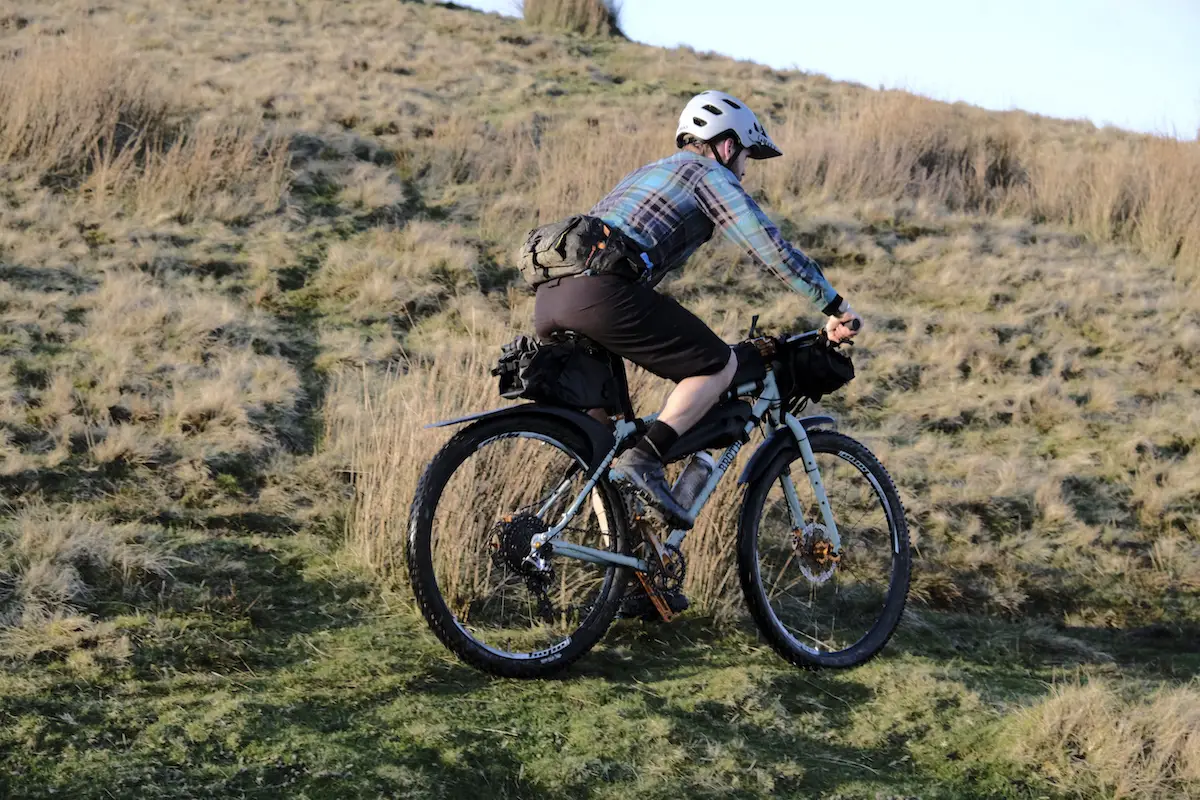
In a sport which places a big emphasis on self-reliance, small bags can be viewed with suspicion. There are folk out there who ride with nothing at all (you’ve probably lent one of them some tools at some point), and there are also people who are happy to forgo things like a jacket in the name of unencumbered riding.
Without wanting to sound like Captain Bringdown’s boring lieutenant, I don’t think this is a good idea. Bikes are capable of taking you a lot further into the wild than your little pottering feet. If you suddenly find yourself having to walk, or worse still, completely immobile, because your ride buddy, your bike or your body are crocked, not having some spare kit could turn a disappointment into a proper misery-fest. So when we picked these bags, we wanted to make sure that they stored a certain amount of stuff. Tools, a pump or inflation device, a spare tube, water, a snack and a small packable jacket were the bare minimum, which ruled out some of the more pared-down carrying solutions out there.
As someone who normally prefers riding with a bigger pack, I’ve tried really hard not to judge these bags on what they can and can’t carry beyond these minimum requirements. There is a huge variation in what each can lug, which bears little relation to the number of litres printed on the label, but they all fitted the basic kit, give or take. I’ve tried to focus on which bags make the most effective use of space, strike a balance between organisation, capacity and ease of use, and simply feel most comfortable.
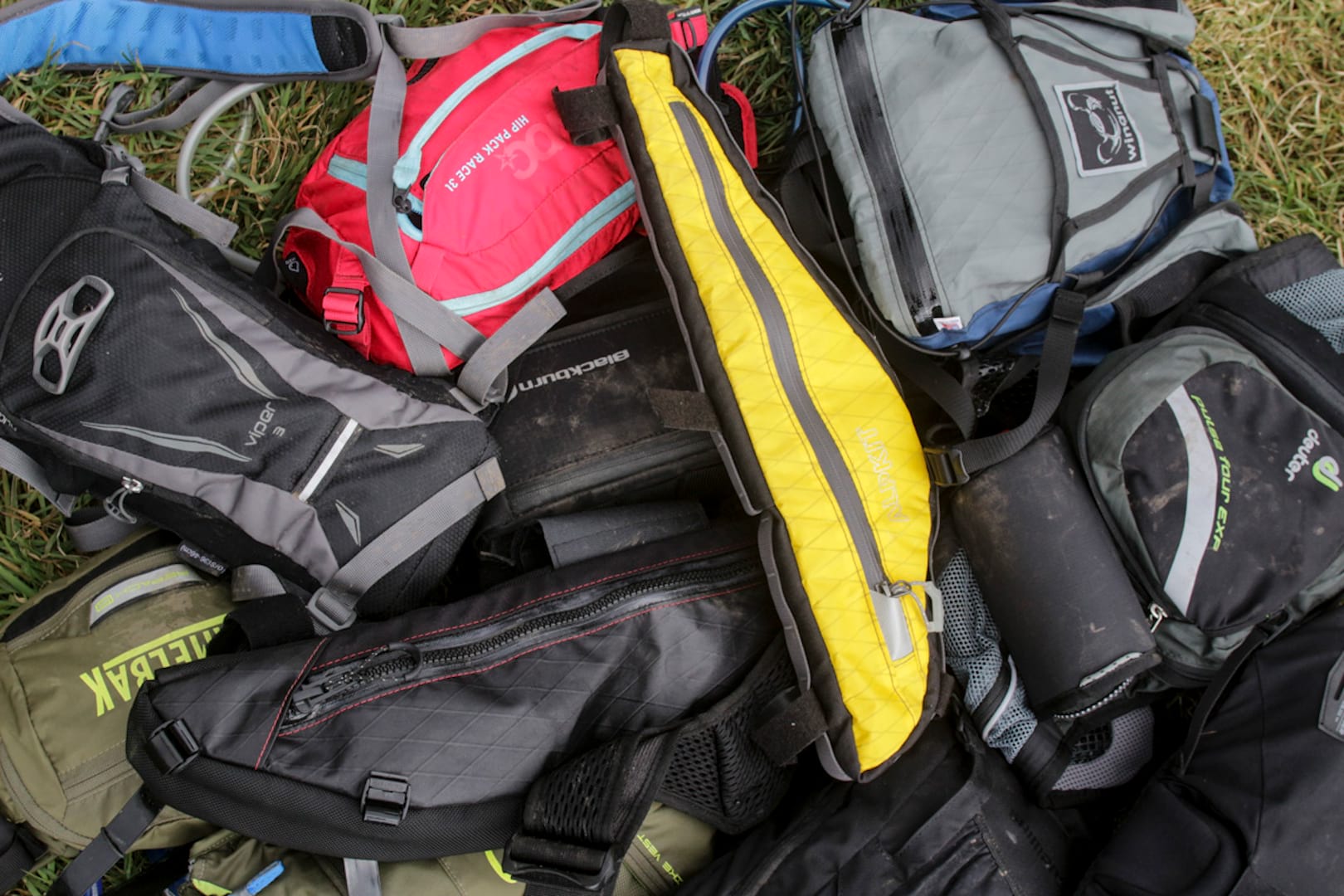
Step inside my wardrobe
There is a bewildering array of smaller bags available these days, and we’ve picked a representative snapshot from three main categories.
First off, we have the micro-packs – basically, a backpack, only smaller. These strip down the classic riding rucksack to its bare essentials, often adding maximum ventilation and a very secure harness along the way to make something that, in theory, you can forget you’re wearing. The capacity of these packs varies dramatically – some are big enough for a day ride, and some are barely more than a bladder with a pocket on the front.

Then there are bum bags. Sorry, hip packs [Ed – Or is it ‘waist packs?’ Or ‘fanny packs’?]. My very first riding bag was a bum bag – in hot pink, natch. Perhaps inevitably, once they were christened as such, bum bags quickly became a comedy punchline, and for a while I thought they’d been banished to the less fashion-conscious reaches of the running world. But it was inevitable that they would return – the lure of riding sans sweaty shoulder blades was just too much. The new generation of enduro-bustles are much cleverer beasts than the fashion carbuncles of yore. The bags we tested all had improved retention systems, to make them less likely to end up round your ankles, more organisational potential, and at least a bottle’s worth of water carrying capacity.
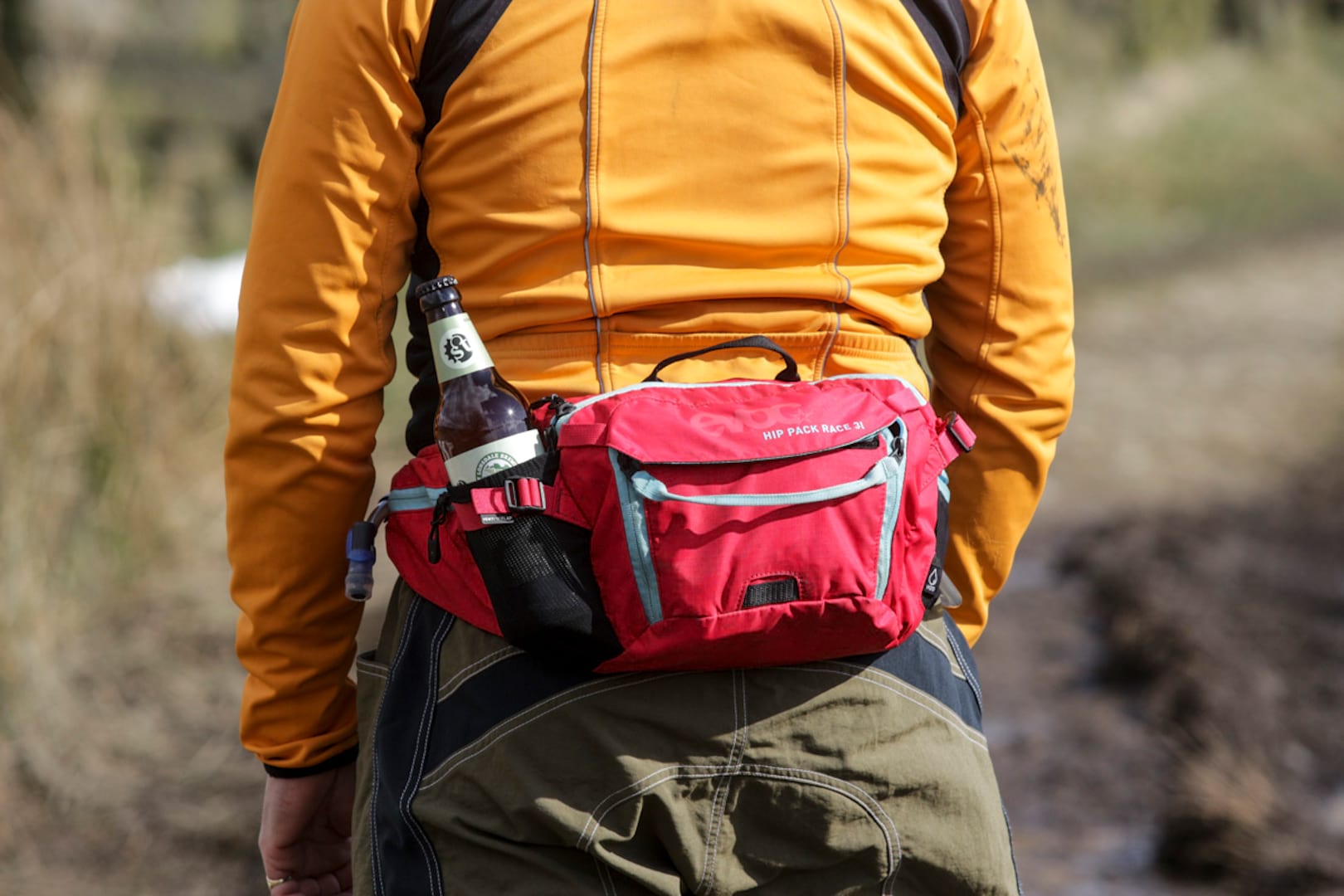
Finally there are the frame bags. Again, these have been around since the dawn of mountain biking, when a colourful isosceles triangle of pressed steel multifunction wrenches and loose jangling Allen keys were as essential as bar ends or toe clips. And again, like waist packs, they underwent a period in the wilderness, before long-distance off-road riders started to look for alternatives to racks and panniers, and bikepacking became a buzzword.
The frame bags in our test have all come from the bikepacking world, but there’s no reason why you shouldn’t use them for everyday rides too. Keeping weight lower down, riding completely free of bodily encumbrances (unless your beer belly counts), and being able to strap a specific set of kit to a specific bike are all good reasons to consider frame-based storage. Long-distance riders will also appreciate them – if you need to eat on the move, it’s much easier to reach in front of you than behind. For these bags, it’s assumed that your bike will be sporting a cage and water bottle too, although some of them also have on-board hydration potential.
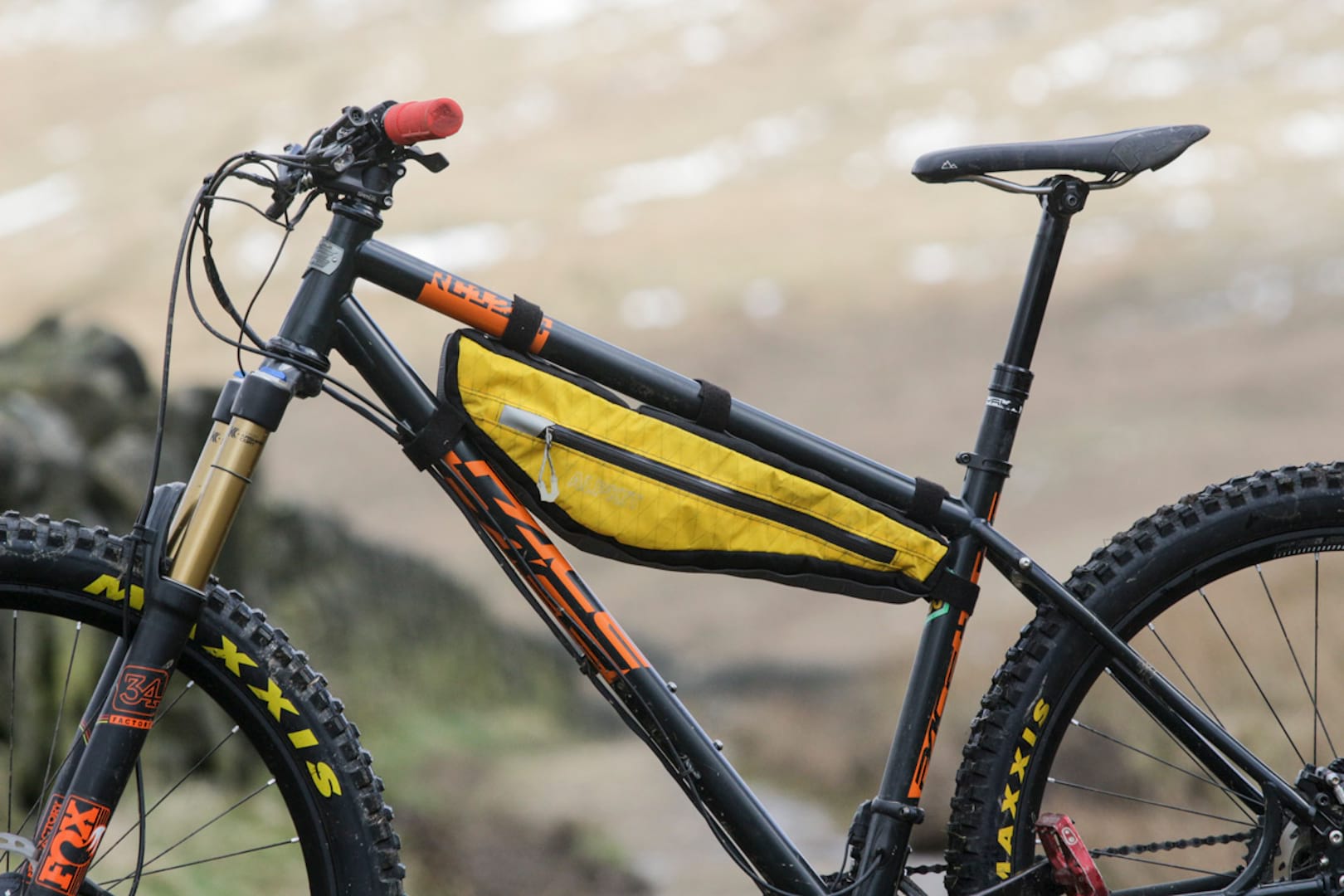
Each type of bag seemed to have its own pros and cons. The rucksacks all do the job you would expect, but they can also feel a bit like you’re just wearing a regular pack with less in, which might not satisfy the bag-o-phobes out there.
Waist packs, meanwhile, are generally quite sensitive to body shape, and as a more, ahem, ‘apple-shaped’ individual, I found it harder to get them all to stay up. Careful packing and adjustment matters more with these bags, and any attempt to overstuff them can make them want to head south. If your abdomen is more like an hourglass than a space hopper, you will probably get along with them much better, but be aware that trying before you buy (perhaps via a spot of vigorous jumping up and down) may save some disappointment.
Frame bags are the rarest out on the trails. Most tend to be a single compartment with a side pocket, making their contents harder to organise without a tool roll or similar. Their position under your bike’s downtube means that they tend to be more suitable for hardtails, and there seems to be a lot of variation in sizing, even with measurements on websites.
With the rules of the test set out, let’s bring on the bags.
Best Waist Pack – CamelBak Repack LR
- Price: £69.99
- From: ZyroFisher

The Repack is the successor to CamelBak’s previous Palos waist pack, which was welcomed by some riders, but also notorious for its self-loosening straps. At 2.5L capacity plus 1.5L of water, it’s on the roomy side for a bum bag, which can be a good thing (more room for your stuff) or a bad thing (constantly tries to get acquainted with your knees).
Weighing in at just over 300g without its bladder, the Repack is a nicely minimalist option, but it still feels like a proper riding pack, instead of a compromise solution. You won’t need to bungee any bits to your frame if you use it, and you won’t need to keep hitching it up either. Not all of CamelBak’s previous attempts at waist packs have hit the mark, but with the Repack LR they’ve nailed it.
Deuter Pulse 4 EXP
- Price: £40.00
- From: Deuter

The Pulse looks like it’s taken its design cues from the running world, and it’s hard to imagine a more methodically organised waist pack, with a pocket specifically designed for everything from your keys to your water bottle. It’s surprisingly capacious, and held a basic riding kit with no issues, including a small pump in the main compartment. It’s also priced to sell, at half the cost of some of the bags in the test.
It feels a bit basic; the buckle can be hard to adjust as you ride and the waist belt is plastic webbing, which feels rather grim next to your skin if your top rides up. However, it does seem to help keep the bag in place, and with a modest payload we didn’t have any issues with it slipping down. The bag is also easy to spin round if you want to get into it without taking it off.
Evoc Hip Pack Race 3L
- Price: £56.95
- From: Silverfish

Evoc bags reek of quality, and with its nice bold colours and watermarked inner lining, the Hip Pack was probably the best looking pack in our grouptest. It’s well organised and easy to get into, and has a wealth of pockets for tools, spares and personal effects. With so much attention to detail, someone has clearly spent a lot of time on the design of this bag.
In use, though, it didn’t live up to its initial promise. No matter how it was packed, or how much we tightened the straps, it frequently slipped down, to the point where any extended period of out-of-the-saddle climbing meant reaching down to hitch it up.
Bontrager Rapid Pack
- Price: £44.99
- From: Trek Bikes

Bontrager’s pack trims the waist pack right back to a minimum. It has zipped left and right-hand pockets, with elasticated internal organisers for tools etc. and a neoprene water bottle sleeve in the middle. And that’s it.
The Rapid Pack has the least capacity in this test, giving rise to issues such as the fact that it won’t take a regular pump in any of the pockets – I had to cram mine down the side of the water bottle, where it poked me in the small of the back like an unwelcome bedmate. Carrying a jacket is also an issue and reaching your water bottle is awkward thanks to the central position
Best Frame Bag – Alpkit Possum
- Price: £60.00 – £70.00
- From: Alpkit

The Possum is one of a range of frame bags made by Alpkit, and it’s the plain vanilla flavour in a range that also includes bags specifically designed for fat bikes, or even full custom options. With the exception of the waterproof, welded seam Rando range, all Alpkit’s bags are made in the UK at their factory near Nottingham, and the Possum is available in loads of different colours, and long, medium and short sizes.
Some frame bags try to maximise storage at the expense of usability, but the Possum avoids these pitfalls. It holds its shape extremely well and doesn’t bulge out to rub your knees, no matter what you stuff in there. It plays well with a bottle cage, even on a small-ish 26er frame. Its versatile mounting system means you won’t have problems with straps rubbing on cable mounts or the like. It measures bang on its claimed 46cm length.
Blackburn Outpost Frame Bag
- Price: £44.99 – £59.99
- From: ZyroFisher

Available in three sizes, the Outpost aims to be two pieces of luggage in one: unzip the concertina section at the bottom, and the top tube bag expands into a full frame pack. Made from tough black water-resistant nylon, it’s shorter than other bags, and a lot deeper. As a result it doesn’t play well with bottle cages, unless you’re riding a very roomy frame with a side access cage.
The interior is very roomy even before you’ve expanded it, and is compatible with a hydration bladder. Sadly the Outpost doesn’t seem very waterproof, and even a short splashy ride was enough to get the contents wet. The Outpost is a neat idea but let down by its execution, and its tendency to take on water.
Ortlieb Frame-Pack Toptube
- Price: £89.99
- From: Lyon Equipment

Here, Ortlieb has picked a much lighter material than many frame bags, and gone minimalist on the design too, with just a single compartment. The pack is stable and easy to access, but thin and flexible so needs careful packing. A light load rattles around inside the single unpadded pocket, while filling it to capacity tends to turn it into a knee-bothering sausage.
It’s a neat piece of minimalist luggage, looks great, and comes with the reassurance of a five-year warranty. However, a stiffer construction and some internal pockets would make this bag a lot more usable for everyday rides and we’d gladly accept the small weight penalty.
Revelate Tangle
- Price: £99.99
- From: Back Country

Alaskan brand Revelate Designs was making soft luggage for bikepacking back when it was only a gleam in a marketing man’s eye. The Tangle was the most full featured of all the frame bags on test, with built-in loops to take a full-size pump and hydration bladder compatibility.
It holds a huge amount, but tends to bulge in a knee-troubling fashion unless carefully packed. It’s also at the weighty end of the spectrum, although given that its intended user will probably be carrying enough food and water for a two-week desert crossing, its chunkiness and capacity are understandable. A great pack, but not the perfect one to leave on your bike all year round.
Winner Best Mini-Pack – Wingnut Hyper 1.8
- Price: £69.99
- From: Rough Ride Guide

Wingnut Gear has been around for a over a decade, but it’s still a small manufacturer and you still don’t see many on the trail. The range includes packs in sizes up to 25L, that all share a similar design. Rather than putting the weight up between your shoulder blades, the packs feature longer straps that drop the load right down, so it sits over your lumbar region.
The Wingnut is stable, weather-resistant, and for a bag with a fair amount of capacity, it certainly doesn’t feel that way when it’s on your back. Some riders will want something that’s a bit smaller, or more of a fashion statement, but the Hyper 1.8 uses a proven design to good effect.
USWE Airborne 3
- Price: £89.99
- From: Madison

USWE’s USP is its distinctive design of harness. Rather like a four-point motor racing seatbelt, the straps on its bags feature just one central locking buckle. The aim of this configuration is to eliminate what USWE refer to as the ‘dancing monkey’ feel of less secure backpacks.
Although this boasts better storage capacity than some packs in USWE’s range, the Airborne 3 barely held the minimum kit for our test, and is more of a bottle for your back than a backpack in its own right. It’s supremely comfortable, but we’d feel happier using it on an uplift day than having it as an only pack for short rides.
Osprey Viper 3
- Price: £75.00
- From: Osprey

If you already have an Osprey bag, the Viper 3 will seem very familiar as it’s basically a cut-down version of its other riding packs. It carries over a lot of features from its bigger cousins, such as Osprey’s signature ‘lid lock’ helmet carrier, and the open-topped stowage pocket that usually sits on the front of their packs to stuff your jacket in, but here provides most of the storage on offer.
The Viper holds a large 2.5L Hydrapak reservoir, but tapers noticeably towards the bottom, making it awkward to access the narrow front pocket. It’s a quality bit of kit, but it feels more like a regular backpack, with less in it, than an excitingly minimalist way to carry your stuff.
Shimano Unzen 4 Enduro
- Price: £109.99
- From: Madison
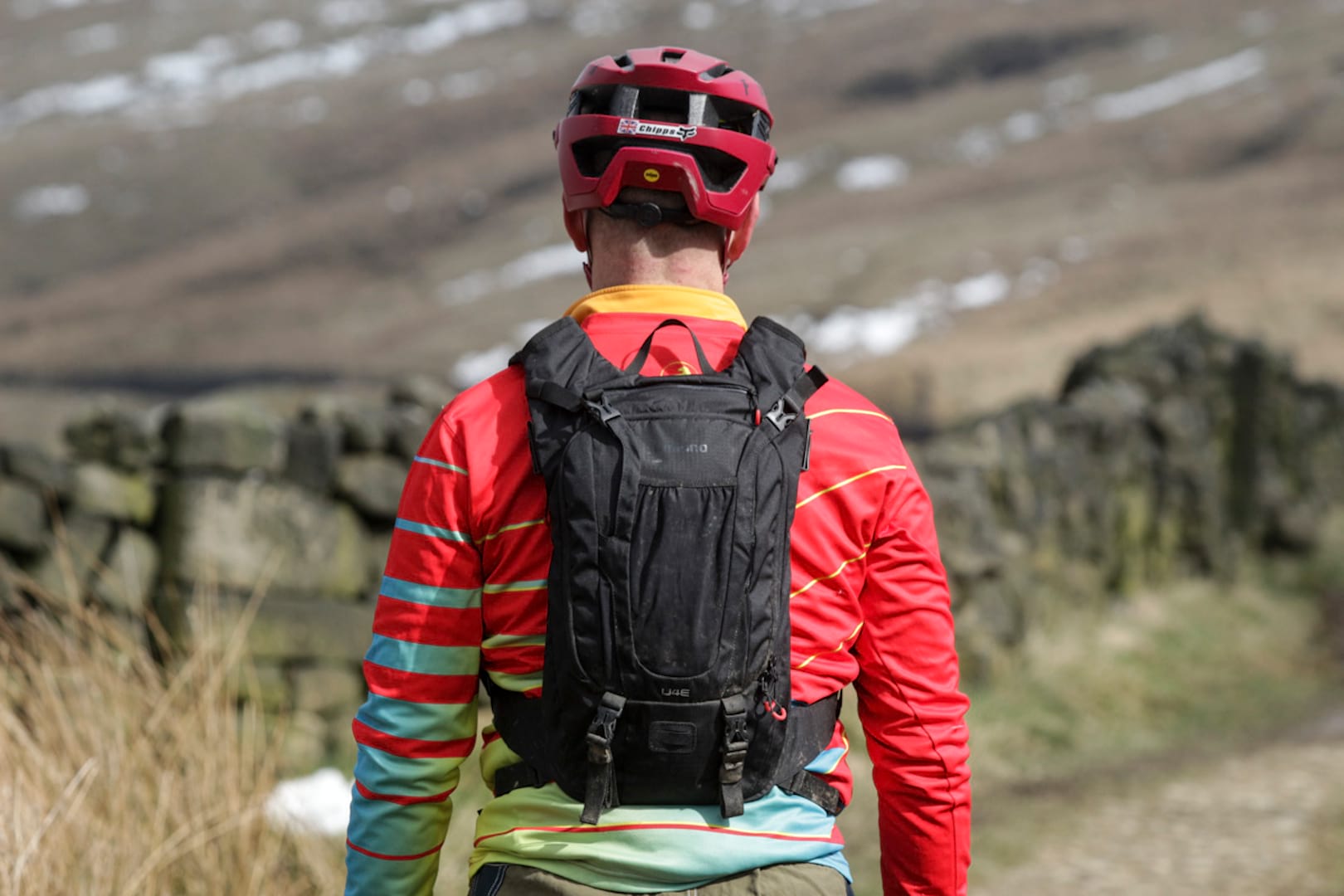
Who knew that Shimano produces a range of riding packs? Targeted at enduro racers, the Unzen 4 Enduro feels like it’s built to last, and has a host of features, including a helmet carrier, bottle pouch, clips for goggles, and a fold-out front pocket with numerous internal compartments and organisers. It’ll also carry your leg armour or a rolled-up jacket, and holds a full-size reservoir to boot.
The X-shaped straps and detachable waist belt keep the bag firmly secured no matter what you’re battering over, but the Unzen also feels like a much bigger pack than it is. It weighs 740g – nearly as much as some other brands’ full-size day packs – and has a very similar footprint. We can’t help thinking that if you’re happy to carry something the size of the Unzen, you might as well go for a regular riding pack.
The Verdict
The range of ways of carrying your stuff seems to be growing exponentially, and it’s the perfect illustration of how the different branches of our sport – and others – can come together to create lots of interesting hybrids. The bags on test here show influences from enduro, bikepacking, and even trail running. It’s a bit like what happened to dogs: after years of looking fairly standard, they diversified into all sorts of shapes, and while some are a bit too tiny to be practical for the outdoors, there’s probably someone out there who will love them.
Such is the pace of change that we could probably re-run this test straight away, with an entirely different selection of bags, and still have as many in there. In some respects this is a good thing, but it’s also annoying when the product for you is phased out of a manufacturer’s line-up. But there are also some, like Revelate and Wingnut, whose line-up stays fairly constant and is more a process of refinement than reinvention.
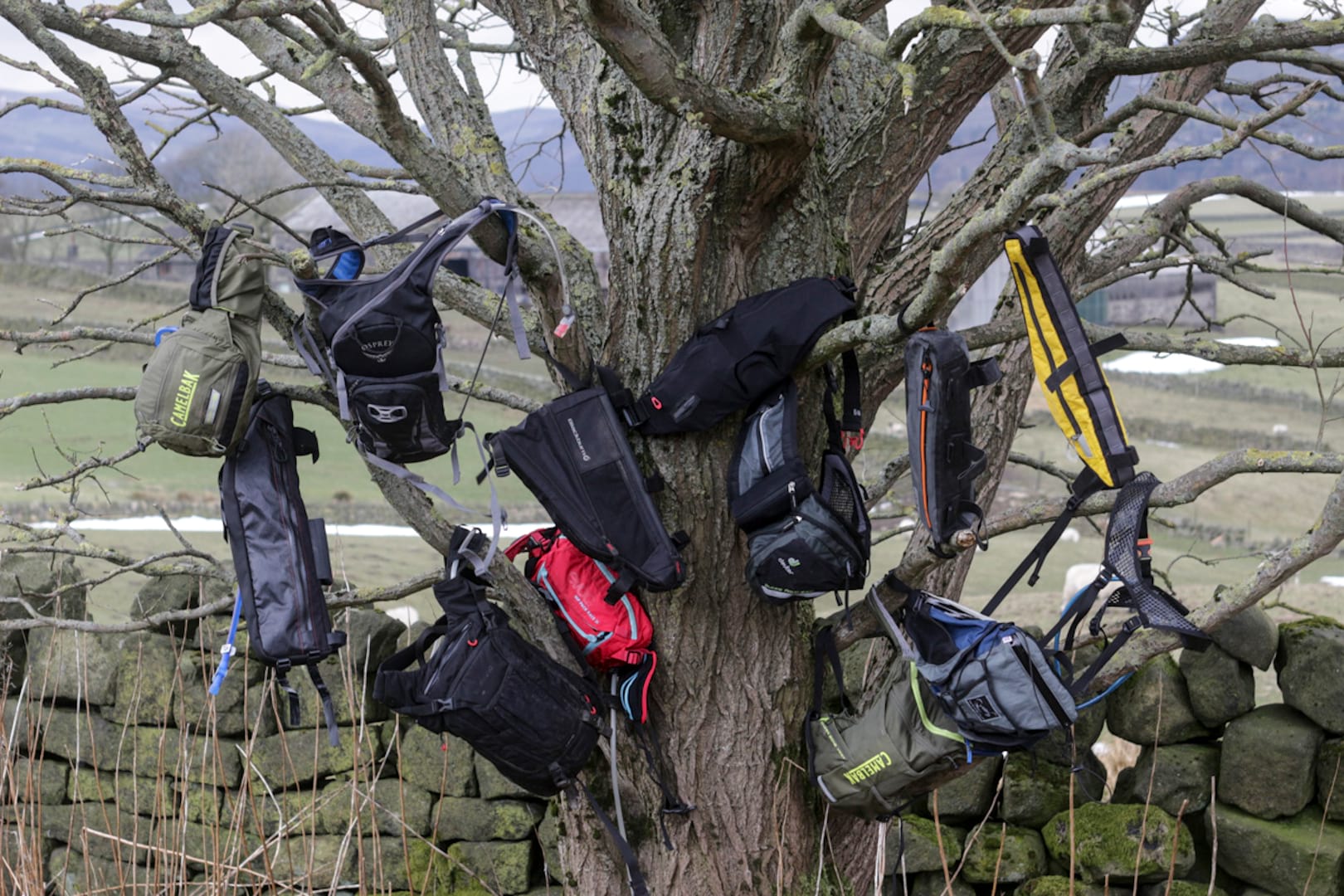
Where the bags in this test didn’t please, it was often because they were asked to do things they simply weren’t designed for, but sometimes it was because they fell foul of the British weather. Testing these in the dark months of the year was perhaps an odd choice, but it did flag some issues that might not be apparent if they were only deployed at the height of summer. By the time you read this, hopefully winter will have released its grip on the UK and the promise of spring will have delivered.
It’s easy to pigeonhole small riding packs as a summer-only item, but many of these are cleverly designed enough to be good for year-round use, as long as you’re not trying to make them go beyond their design brief. After all, when the weather’s grim, you probably don’t want to head out for a six-hour epic. Equally, you don’t want to be stuck for want of a vital spare part, or feeling the hunger knock at the furthest point of your ride.
Some of these bags might incur tutting from the folk who head out prepared for any eventuality, and that’s understandable – they do force you pare your kit down to a bare minimum. Then again, if the alternative to taking one of these is leaving some vital part of your ride kit strapped to the wrong bike, or not taking anything at all, we’ll go with the micro-bag every time.
This article was originally featured in Singletrack Magazine. Keen to read more? Then make sure you check out all the stories and reviews in Issue #118 right here!






Is it possible to fit a 12″ 2in1 ultrathin laptop inside the Shimano Unzen backpack?
I use an Aldi backpack about the same size as the Viper and it takes a bladder (not included). Cost £12. Has a right orange foldaway waterproof cover in the base. Works a treat, takes tools, spares and an iPad Mini.
@centrifuge: if memory serves correctly, it doesn’t have a single main compartment. You might be able to carry a notebook PC in the bladder pouch, but having one next to a big bag of water might be risky.
@MrAgreeable: Thank you. I’m thinking of using it to carry my laptop and clothes on a 45′ ride after work three times a week. No water bladder needed